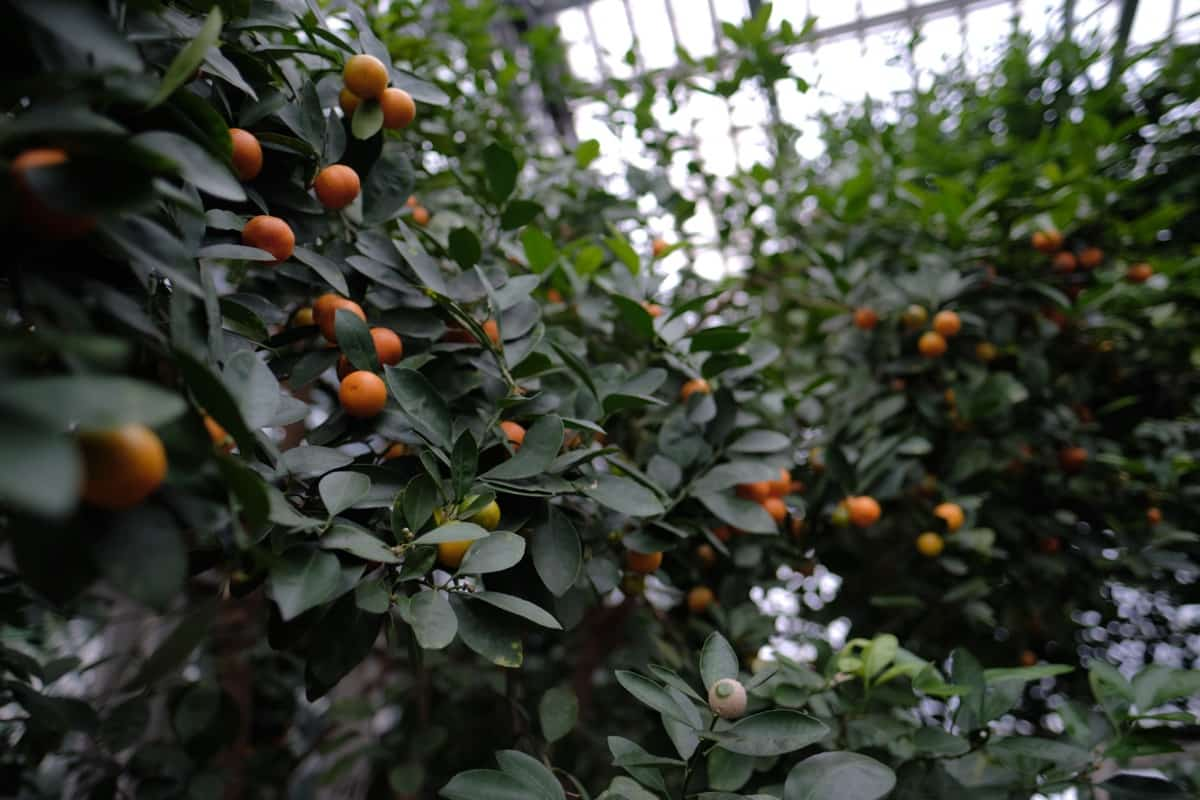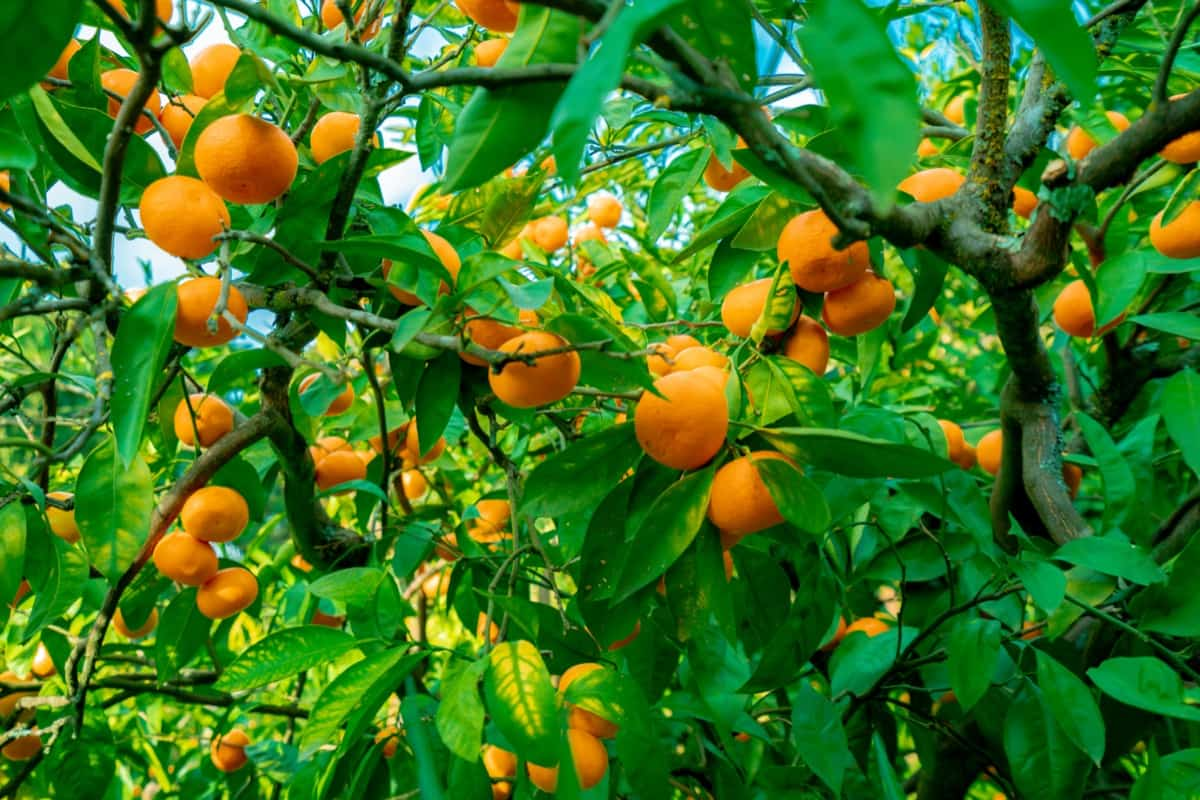Tangelos, a unique and delicious citrus fruit, are a cross between tangerines and grapefruits. They have a vibrant orange color with slightly bumpy skin that is easy to peel. Growing Tangelos in the backyard can be a rewarding and fruitful experience. With their unique combination of sweetness and tanginess, these citrus fruits will surely delight your taste buds. You can enjoy fresh Tangelos straight from your backyard by understanding the available varieties, properly planting and propagating them, ensuring pollination, providing proper care, and enjoying their bountiful yield.

How to Grow Tangelos in the Backyard
Introduction to Tangelos: A Guide to Growing Tangelos in Your Backyard
Tangelos, a delightful and tangy citrus fruit, is perfect for your backyard garden. Their unique flavor and easy-to-grow nature offer a rewarding experience for any home gardener. One of the first steps in growing Tangelos is selecting the right variety for your specific climate and preferences. Before planting your Tangelo tree, properly preparing the soil is important. Tangelos thrive in well-drained soil that is rich in organic matter. Choose a sunny location with plenty of space for growth. Dig a hole and gently place the tree into it.
Backfill with soil while ensuring that the graft union remains above ground level. If you’re interested in propagating Tangelos from seeds or through grafting techniques like budding or whip-and-tongue grafting, various methods can be employed depending on personal preference. To ensure successful pollination of your Tangelo trees and maximize fruit production, attracting pollinators such as bees’ butterflies can be achieved by planting flowers nearby that attract these beneficial insects; providing them with nectar-rich food sources throughout their active season will encourage frequent visits to your garden.
Proper care of Tangelo trees involves regular watering, especially during dry spells, and providing sufficient nutrients through appropriate fertilization at key times throughout the year. Pruning branches annually helps maintain shape and promote airflow. Pest diseases can be controlled effectively by practicing good sanitation measures, regularly inspecting trees for signs of infestation, and treating problems promptly as they arise using organic or chemical alternatives.
Choosing the Right Tangelo Variety for Your Backyard Garden
Choosing the right Tangelo variety for your backyard garden is an important decision that can greatly affect the success of your citrus fruit harvest. One popular Tangelo variety is the Minneola. Known for its large size and sweet-tart flavor, Minneolas are a favorite among citrus enthusiasts.
In case you missed it: Sweet Dreams with 15 Most Fragrant Flowers to Grow in the Bedroom

They also have a distinct bell shape and deep orange color that adds visual appeal to any backyard garden. Another option to consider is the Orlando Tangelo. These fruits are slightly smaller than Minneolas but still pack a punch in flavor. They are bright orange and offer a juicy sweetness with just enough tanginess to keep things interesting.
Preparing the Soil for Tangelo Planting: Tips and Techniques
The right soil conditions will give your Tangelo trees the nutrients and drainage they need to thrive. Start by choosing a well-draining location for planting your Tangelo trees. This will help prevent waterlogged roots and ensure proper moisture levels. If you have heavy clay, mix organic matter such as compost into the soil. This will improve the soil structure and enhance nutrient availability.
Before planting, remove any weeds or grass from the area to eliminate competition for resources. Tangelos prefer slightly acidic soils with a pH range of 6-7. Consider adding slow-release fertilizer specifically formulated for citrus trees before planting. This will provide essential nutrients over an extended period and support healthy growth. Once you’ve prepared the soil, create holes twice bigger than the root ball but no deeper than its height when transplanting young Tangelo trees from containers into their permanent positions in your backyard garden.
Planting Tangelo Trees: Step-by-Step Instructions for Success
Following the right steps is crucial for successfully planting Tangelo trees. First and foremost, choose a suitable location for your Tangelo tree. It should be in an area with full sunlight and well-drained soil. Avoid low-lying areas or spots prone to flooding. Next, prepare the soil by loosening it with a garden fork or tiller.
Dig a hole twice bigger than the root ball of your Tangelo tree. Gently place the tree into the hole, ensuring it sits at the same depth as in its container. Backfill the hole with soil, firmly pressing around the tree’s base to eliminate air pockets. Mulch around your newly planted Tangelo tree using organic materials like wood chips or straw. This will help conserve moisture, suppress weed growth, and regulate soil temperature. Water regularly during dry periods, ensuring your Tangelo tree receives about 1 inch of water per week until established.
Tangelo Propagation Methods: From Seeds to Grafting
Starting from seeds is one option for growing Tangelos. Begin by removing the seeds from a ripe fruit and cleaning them thoroughly. Plant the Tangelo seeds in a well-draining potting mix, keeping them moist but not waterlogged. It may take several weeks for seedlings to emerge, so be patient. Another popular method of propagating Tangelos is through cuttings or grafting onto rootstocks. Take healthy branches or stems from existing trees and prepare them for grafting by removing leaves or thorns.
In case you missed it: 19 Stunning French Flowers That are Easy to Grow at Home

Then, select a suitable rootstock that matches your desired tree size and characteristics. Grafting involves joining the cutting or scion with the rootstock using specific techniques like whip-and-tongue or cleft grafting. This allows for better control over tree growth and ensures desirable fruit quality. Regardless of your chosen method, providing optimal conditions for successful propagation is important. Maintain consistent moisture levels, protect young plants from extreme temperatures, and monitor their overall health regularly.
Attracting Pollinators to Your Tangelo Trees: Tips for Successful Pollination
Pollination plays a vital role in the fruit production of Tangelo trees. Consider planting companion flowers near your Tangelo trees. Flowers like Lavender, Marigold, and Cosmos attract pollinators with their vibrant colors and sweet nectar. These beautiful blooms will be beacons for bees and other flying insects looking for a tasty treat. Creating a diverse ecosystem is another key factor in attracting pollinators. Incorporate native plants into your garden design that provide food sources throughout the year.
This way, you’ll have a constant supply of visitors who will happily assist in pollinating your Tangelos. Additionally, avoid using chemical pesticides on or near your Tangelo trees. These chemicals can harm the pollinators and the delicate balance of nature within your garden. Instead, opt for organic pest control methods that won’t harm our winged friends. Providing a water source is essential for attracting pollinators. Bees especially appreciate shallow dishes filled with fresh water where they can safely hydrate while taking breaks from their important work.
Tangelo Tree Care: Watering, Fertilizing, and Pruning Guidelines
Watering your Tangelo trees is crucial for their overall health and fruit production. These citrus trees thrive in well-drained, evenly moist soil but not waterlogged. During the warmer months, it’s important to water them deeply once or twice a week, ensuring that the top few inches of soil are thoroughly soaked. In cooler months, you can reduce watering frequency. When fertilizing Tangelo trees, a balanced citrus fertilizer will give them the necessary nutrients to flourish.
Apply the fertilizer according to package instructions in early spring and again in late summer. Pruning is another essential aspect of Tangelo tree care. Regular pruning helps maintain their shape and promotes better air circulation within the canopy, reducing disease risk. Remove dead or damaged branches throughout the year and prune for shape during winter dormancy. Be cautious not to remove more than 25% of the total foliage.
Protecting Tangelo Trees from Pests and Diseases: Common Issues and Solutions
One common issue that Tangelo trees face is citrus leaf miner. These tiny pests leave silvery trails on the leaves and can severely stunt growth. To combat this problem, you can use organic insecticides or introduce natural predators like ladybugs. To shield your Tangelo trees from fungal infections like root rot or powdery mildew, ensure proper air circulation by pruning branches regularly to allow sunlight penetration into the canopy.
In case you missed it: How Long it Takes to Grow Mushrooms at Home: Factors Affecting the Growth Rate of Mushrooms

Also, avoid overwatering and provide well-draining soil conditions. By staying vigilant and implementing preventative measures against pests and diseases while providing optimal care for your Tangelo trees, you can protect them effectively from potential threats throughout their growth cycle.
Harvesting Tangelos: Signs of Ripeness and Proper Harvesting Techniques
When it comes to harvesting Tangelos, timing is everything. You want to make sure you pick the fruit at its peak of ripeness for maximum flavor and juiciness. One of the best indicators of ripeness is color. Tangelos should have a vibrant orange hue when fully ripe, with no traces of green or yellow remaining on the skin. Another sign to look for is firmness – a ripe Tangelo will feel slightly soft when gently squeezed.
To harvest your Tangelos, twist them off the branch gently upwardly. Avoid pulling or yanking, as this can damage the fruit and the tree. If your Tangelo doesn’t come off easily, it may still need to be fully ripe, so give it some more time. Once you’ve harvested your luscious Tangelos, handle them carefully to prevent bruising or puncturing.
Storing and Preserving Tangelos: Tips for Long-Term Enjoyment
Storing and preserving Tangelos is key to ensuring you can enjoy their delicious flavor long after harvest season has ended. First, handling Tangelos carefully is important when picking them from the tree. Avoid any bruising or damage that could compromise their shelf life. Keep Tangelos at room temperature for short-term storage, away from direct sunlight. They can last up to two weeks this way, ready for quick snacking or adding zesty flavor to your favorite recipes. If you want to extend their lifespan further, consider refrigerating your Tangelos.
Common Challenges in Growing Tangelos and How to Overcome Them
Growing Tangelos in your backyard can be a rewarding experience, but it does come with its fair share of challenges. One common challenge that gardeners face is poor soil quality. Tangelo trees thrive in well-draining soil that is rich in organic matter. To overcome this challenge, you can amend the soil by adding compost or aged manure before planting.
Another challenge is pest infestation. Tangelo trees are susceptible to pests such as aphids, scale insects, and citrus leaf miners. To combat these pests, regular monitoring is key. Inspect your trees frequently for any signs of infestation and take immediate action if necessary. You can use natural remedies to control these pests without harming beneficial insects.
Inadequate pollination can also hinder fruit production in Tangelo trees. Bees are excellent pollinators for citrus trees, so creating an inviting environment is crucial. Planting flowering plants nearby or using bee-friendly attractants can help attract bees to your garden. Watering properly is another challenge that many gardeners face when growing Tangelos. Watering deeply but infrequently is important, allowing the topsoil to dry out between watering sessions.
Extreme weather conditions like frost or heatwaves can threaten Tangelo trees’ health and productivity. Providing protection during colder months with blankets or frost cloth and shade during hot summer days through shading structures or mulching around the tree’s base can help mitigate these challenges.
In case you missed it: Top 15 Papaya Varieties to Grow in Your Garden: A Guide for Beginners

Tangelo Tree Maintenance: Yearly Tasks for Healthy Growth and Fruit Production
Regular maintenance ensures your Tangelo trees’ healthy growth and abundant fruit production. Prune your Tangelo tree to remove damaged branches in early spring. Apply a balanced fertilizer formulated for citrus trees in early spring. Repeat this application every six weeks during the growing season to provide the necessary nutrients. Tangelos need consistent moisture but should not be overwatered.
Water deeply once a week during dry periods, ensuring the soil is evenly moist. Apply organic mulch to conserve moisture and suppress weeds. Keep the mulch away from the trunk to prevent rotting. Regularly inspect your Tangelo tree for signs of pests like aphids or scale insects. If detected, treat with insecticidal soap or horticultural oil according to label instructions.
Maximizing Fruit Yield: Tips for Increasing Tangelo Production in Your Backyard
If you’re growing Tangelos in your backyard, you probably want to enjoy a plentiful harvest. Proper pruning is essential for promoting healthy growth and abundant fruiting. Regularly trim any dead or diseased branches to maintain the tree’s health. Additionally, thinning out crowded areas will improve air circulation and sunlight exposure, leading to better fruit development. Providing adequate water is crucial for Tangelo trees.
While they are known to be somewhat drought-tolerant once established, consistent irrigation during dry spells will ensure optimal growth and fruit production. Fertilizing regularly is another key factor in boosting Tangelo’s production. Apply a balanced citrus fertilizer according to package instructions during the growing season. This will provide essential nutrients that support healthy foliage and encourage more flowers and fruits. Furthermore, pollination plays a vital role in achieving high yields.
To attract bees and other beneficial insects needed for successful pollination, plant flowering companion plants nearby, such as Lavender or Marigolds. These colorful additions not only enhance your garden’s visual appeal but also help attract pollinators. Monitoring pest infestations closely is crucial as they can significantly impact fruit yield if left unchecked. Use organic pest control methods to avoid introducing harmful chemicals into your backyard ecosystem.
In case you missed it: Best Fertilizer for Orange Trees: Organic, NPK Ratio, Management, Schedule, How and When to Apply

Conclusion
Tangelos are a unique and delicious citrus fruit that crosses between a tangerine and a grapefruit. By creating the best growing environment for your Tangelo trees and being diligent in their care, you’ll soon be rewarded with beautiful foliage, fragrant blossoms, and an abundant harvest year after year.
- How to Grow Hibiscus from Flower
- Plantation Ideas for Home Decoration: A Beginners Guide
- Flower Garden Designs and Layouts for Beginners
- Planting and Spacing Techniques in Papaya: A Beginner’s Guide
- Growing Gold: Essential Techniques for Planting Pineapples
- How to Make Kalanchoe Plant Bushy: Home Remedies and Solutions
- 11 Reasons Why Your Gardenia is Not Blooming: Home Remedies and Solutions
- Eco Elegance: The Guide to Designing a Drought-Tolerant Landscape
- Gardening on a Slope: Strategies for Hillside Landscaping
- Nourish and Flourish: Top Organic Mulches for Thriving House Plants
- Everything You Want to Know about Indian Mogra Flower: Discover Uses and Growing
- Green Thumb Success: Expert Tips for Cultivating Greenhouse Pumpkins All Year Round
- Maximize Growth & Flavor: The Ultimate Guide to Companion Planting in Herb Gardens
- How to Control Rhododendron Problems Naturally: Home Remedies and Organic Ways to Fix Them
- Natural Magic: The Remarkable Benefits of Cinnamon for Plants
- Best Steps to Revive Dying Tulip with Natural and Organic Treatment
- 10 Reasons Why Your Angel Trumpet is Not Blooming: Remedies and Treatment
- How to Fix Periwinkle Leaf and Flower-Related Problems: Natural Remedies and Solutions
- How to Fix Zinnias Leaf and Flower Problems: Discover Natural and Home Remedies
- Organic Steps to Induce Lemon Tree Flowers: A Comprehensive Guide
- Bloom Booster: Crafting the Perfect Homemade Bougainvillea Fertilizer
- Optimizing Growth: A Guide to Applying NPK Fertilizer for Potted Plants
- 10 Best Homemade Fertilizers for Rubber Plant: DIY Recipes and Application Method
- How to Boost Female Pumpkin Flowers: Effective Steps for More Flowers and High Yields
- Transform Your Indoor Garden: Top Benefits of Pink Salt for Houseplants
- 10 Best Homemade Fertilizers for Peacock Plants (Calathea): Easy DIY Guide
- Unlock Blooms: 9 Reasons Why Your Potted Chrysanthemum is Not Blooming
- 8 Reasons Why Your Potted Hibiscus is Not Blooming: Fix it with Simple Solutions
- Unlock Blooms: 9 Key Reasons Your Potted Frangipani Won’t Flower
- 10 Reasons Why Is My Ice Plant Not Blooming: Remedies and Treatment
- 10 Reasons Why My Potted Hydrangea Not Blooming: Treatment and Remedies
- 10 Reasons Why is My Wisteria Not Blooming: Remedies and Treatment
- 10 Reasons Why is My Goldfish Plant Not Blooming: Remedies and Treatment
- Maximize Your Space: Ultimate Guide to Balcony Gardening with Grow Bags
- 10 Reasons Why Your Iris is Not Blooming: Remedies and Treatment
- 10 Reasons Why Your Anthurium Plant is Not Blooming: Treatment and Remedies